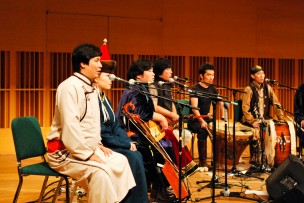
Dan Goldman/Contributing Photographer
Last Friday, Inner Mongolia’s AnDa Union played a vigorous fusion of songs from various steppe traditions for a full house at Crowell Concert Hall. They succeeded in tearing the roof off the building.
AnDa Union, a tight-knit group of ten musicians, has a mission: to preserve and breathe new life into traditional Mongolian music, which has survived, like the rest of Mongolian culture, for thousands of years through the oral traditions of the nomadic peoples who now occupy Mongolia (Outer Mongolia), Inner Mongolia (a massive province in northern China), and Tuva (a region of Russia).
on stage and relaying their musical influences to foreign audiences.” Genghis Khan’s grandson Kublai, by the year 1260 BCE—just two generations after his grandfather first united the tribes of the steppe—ruled over an empire that reached from the east coast of China to the gates of Vienna. Today, Mongolian culture lives on in Mongolia, China, Russia, and in immigrant communities across Europe. If groups like AnDa Union continue to make music, the culture will live for another thousand years still.
In Mongolian, “Anda” means “blood brother or sister.” According to the group’s official profile, “Anda is more important than a birth brother as you choose a person to become anda, a life-long blood brother. AnDa Union is a brotherhood of Andas.”
Traditional Mongolian music is based on a unique vocal capability: throat singing, or “khoomii”—a form of guttural chant, the practitioners of which are able to produce simultaneously as many as four distinct vocal tones through the manipulation of resonances. Nearly impossible for most people to learn, the sound is otherworldly and enthralling.
The Union members’ English is close to nonexistent, but the music spoke for itself. The band is a non-western chamber orchestra of sorts, but their instruments (morin huur, or “horse-head fiddle”—a sonorous two-string instrument that sounds like a cross between a viola and cello—along with other two-string instruments, drums, a percussion instrument made out of vertebrae, and a reed flute) take a back seat to the singing, which is the heart of the music.
The band’s dynamic sound had the audience enthralled, if a room full of stunned, open mouths is any indication. The final song, “Galloping Horses,” evoked a frenzied stampede that sent concertgoers stumbling, crazed and uplifted, out into the night.
Horses are central to Mongolian grassland culture. So is Genghis Khan (or “Chinggis,” if you want to speak correctly, according to the band’s profile). And the songs had plenty of room for the Great Kahn and the beasts that bore his armies. But there was also room for love, loss, and everyday storytelling—not that I could understand any of it.
On Saturday morning, the band held a small throat singing workshop in the World Music Hall. A few students came close to producing the distinctive sounds. All I did was hurt my throat.
After the Union had left town for a show in Boston, I caught up with Andrew Colwell, a graduate student studying Mongolian throat singing in the ethnomusicology department.
“I think it’s really important to promote a more complete understanding of what Mongolian music is, or what music from another culture is,” he said. “And that ties into a general need for better intercultural understanding across the board.”
Colwell lived in Mongolia for several years, teaching English and learning to throat sing. He enjoyed the concert, partially because it presented an opportunity to speak Mongolian again.
“[AnDa Union is] damn good,” he said. “They’re very attuned to being on stage and relaying their musical influences to foreign audiences.”
Genghis Khan’s grandson Kublai, by the year 1260 BCE—just two generations after his grandfather first united the tribes of the steppe—ruled over an empire that reached from the east coast of China to the gates of Vienna. Today, Mongolian culture lives on in Mongolia, China, Russia, and in immigrant communities across Europe. If groups like AnDa Union continue to make music, the culture will live for another thousand years still.
-
Joanne J S vaughns
-
Bob
-